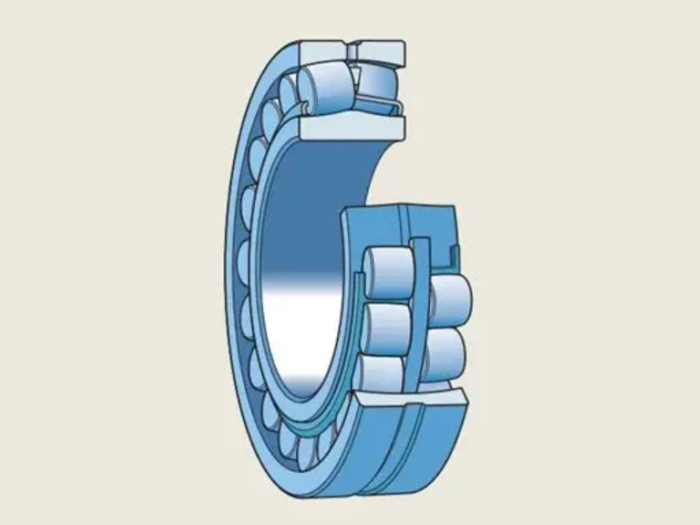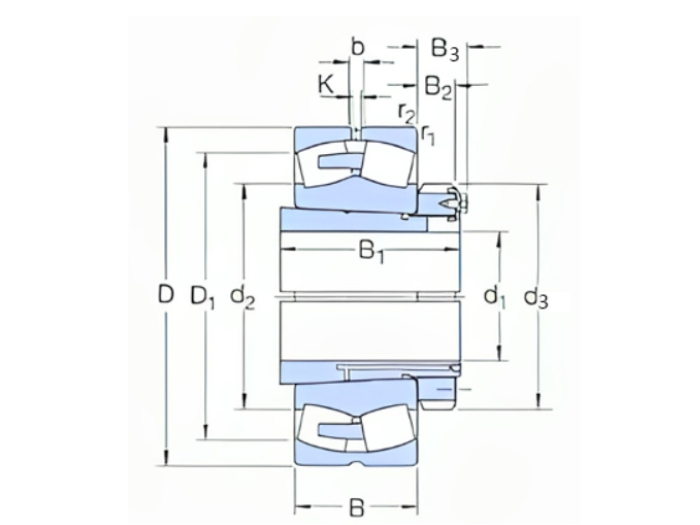Why are spherical roller bearings chosen for wind turbine gearboxes?
Wind energy has become an increasingly important source of renewable power, and the efficiency of wind turbines plays a crucial role in maximizing energy production. At the heart of these massive machines lies a critical component: the gearbox. Within the gearbox, spherical roller bearings have emerged as the preferred choice for many manufacturers and engineers. These specialized bearings are designed to handle the unique challenges posed by wind turbine operations, including high loads, variable speeds, and potential misalignment issues. Their ability to accommodate both radial and axial loads while maintaining alignment even under challenging conditions makes them ideal for this application. In this blog post, we'll explore the reasons behind the widespread adoption of spherical roller bearings in wind turbine gearboxes and delve into their specific advantages that contribute to the overall performance and longevity of wind turbines.

What makes spherical roller bearings ideal for wind turbine applications?
Load-bearing capacity
Spherical roller bearings are specifically designed to handle high radial and axial loads, making them perfect for wind turbine gearboxes. These bearings feature two rows of rollers that are housed within a spherical outer raceway, allowing for an even distribution of stress across the bearing surface. This unique design enables spherical roller bearings to support the immense forces generated by wind turbines, which can vary greatly depending on wind conditions. The robust construction of these bearings ensures they can withstand the constant cyclic loading experienced in wind turbine operations, contributing to extended gearbox life and reduced maintenance requirements. Furthermore, the load-bearing capacity of spherical roller bearings helps to minimize energy losses within the gearbox, ultimately improving the overall efficiency of the wind turbine system.
Self-aligning capabilities
One of the key advantages of spherical roller bearings in wind turbine applications is their self-aligning capability. This feature is crucial in accommodating the inevitable misalignments that occur due to the flexing of the turbine structure under varying wind loads. The spherical outer raceway allows the rollers to adjust their position automatically, maintaining optimal contact with the raceways even when the shaft becomes misaligned. This self-aligning property of spherical roller bearings helps to distribute the load evenly across the bearing surface, reducing stress concentrations and minimizing wear. As a result, the bearings can operate more efficiently and have a longer service life, even under challenging conditions. The ability of spherical roller bearings to self-align also simplifies installation and maintenance procedures, making them a cost-effective choice for wind turbine manufacturers and operators.
Durability and reliability
Spherical roller bearings are renowned for their exceptional durability and reliability, which are essential qualities for components used in wind turbine gearboxes. These bearings are typically manufactured using high-quality materials such as heat-treated steel, which provides excellent resistance to wear and fatigue. The spherical design of the outer raceway and rollers allows for better lubrication distribution, reducing friction and heat generation during operation. This improved lubrication helps to extend the bearing's lifespan and maintain its performance over time. Additionally, spherical roller bearings are often equipped with seals or shields to protect against contamination, further enhancing their durability in the harsh environments where wind turbines operate. The combination of these features results in a bearing that can withstand the demanding conditions of wind turbine gearboxes, minimizing downtime and maintenance costs for operators.
How do spherical roller bearings contribute to wind turbine efficiency?

Reduced friction and energy loss
Spherical roller bearings play a significant role in improving wind turbine efficiency by minimizing friction and energy loss within the gearbox. The spherical design of these bearings allows for a more even distribution of the load across the rolling elements, reducing the overall friction generated during operation. This reduction in friction translates to less energy being wasted as heat, allowing more of the wind's kinetic energy to be converted into electrical power. Furthermore, the self-aligning capability of spherical roller bearings ensures that they maintain optimal contact even under misaligned conditions, preventing increased friction that could result from poor alignment. The combination of these factors contributes to a more efficient power transmission system, ultimately improving the overall performance of the wind turbine and increasing its energy output.
Improved load distribution
One of the key advantages of spherical roller bearings in wind turbine gearboxes is their ability to distribute loads more effectively. The spherical outer raceway and roller design allow for a larger contact area between the rolling elements and the raceways, spreading the load across a greater surface. This improved load distribution helps to reduce stress concentrations within the bearing, minimizing the risk of premature failure and extending the overall lifespan of the component. Additionally, the ability of spherical roller bearings to handle both radial and axial loads simultaneously makes them ideal for the complex loading conditions experienced in wind turbine gearboxes. By efficiently managing these varied loads, spherical roller bearings contribute to the overall stability and reliability of the gearbox, ensuring smooth and consistent power transmission from the rotor to the generator.
Enhanced adaptability to operating conditions
Spherical roller bearings demonstrate exceptional adaptability to the diverse operating conditions encountered in wind turbine gearboxes. These bearings are designed to accommodate shaft deflections and misalignments that can occur due to the dynamic nature of wind turbine operations. The self-aligning feature of spherical roller bearings allows them to adjust to these changes without compromising their performance or efficiency. This adaptability is particularly crucial in large-scale wind turbines, where the forces and movements experienced by the gearbox can be substantial. Furthermore, spherical roller bearings can operate effectively across a wide range of speeds and temperatures, making them suitable for various wind conditions and geographical locations. Their ability to maintain optimal performance under varying circumstances contributes to the overall reliability and consistency of wind turbine power generation, regardless of external factors.
What are the long-term benefits of using spherical roller bearings in wind turbine gearboxes?

Extended gearbox lifespan
One of the most significant long-term benefits of using spherical roller bearings in wind turbine gearboxes is the extended lifespan they provide to the entire gearbox assembly. These bearings are engineered to withstand the harsh operating conditions typical of wind turbines, including high loads, variable speeds, and potential misalignments. The durability of spherical roller bearings helps to reduce wear and tear on other gearbox components, ultimately prolonging the life of the entire system. By minimizing the need for frequent replacements or repairs, wind turbine operators can significantly reduce maintenance costs and downtime. The extended gearbox lifespan facilitated by spherical roller bearings also contributes to the overall sustainability of wind energy projects, as it reduces the need for replacement parts and the associated environmental impact of manufacturing and transporting these components.
Reduced maintenance requirements
Spherical roller bearings contribute significantly to reducing the maintenance requirements of wind turbine gearboxes. Their robust design and self-aligning capabilities make them less prone to premature failure, reducing the frequency of unscheduled maintenance interventions. The improved load distribution and reduced friction offered by these bearings also help to minimize wear on other gearbox components, further decreasing the need for regular maintenance. Additionally, many spherical roller bearings used in wind turbine applications are equipped with advanced sealing systems that protect against contamination, extending the intervals between lubrication and cleaning procedures. This reduction in maintenance needs not only lowers operational costs but also increases the overall availability and productivity of wind turbines. For wind farm operators, the decreased maintenance requirements translate to improved reliability and increased energy production over the long term.
Improved overall turbine performance
The use of spherical roller bearings in wind turbine gearboxes contributes significantly to improved overall turbine performance. These bearings play a crucial role in ensuring efficient power transmission from the rotor to the generator, minimizing energy losses in the process. Their ability to handle both radial and axial loads while maintaining alignment helps to reduce vibrations and noise, leading to smoother turbine operation. This enhanced stability can result in increased energy output and improved power quality. Furthermore, the reliability and durability of spherical roller bearings contribute to higher turbine availability rates, allowing wind farms to maximize their energy production potential. The improved performance facilitated by these bearings can lead to better return on investment for wind energy projects, making them more economically viable and attractive to investors. As the wind energy sector continues to grow and evolve, the role of spherical roller bearings in enhancing turbine performance will remain crucial in meeting the increasing demand for clean, renewable energy.
Conclusion
Spherical roller bearings have proven to be an indispensable component in wind turbine gearboxes, offering a unique combination of load-bearing capacity, self-aligning capabilities, and durability. Their ability to enhance efficiency, reduce maintenance requirements, and extend gearbox lifespan makes them a crucial factor in the overall performance and economic viability of wind energy projects. As the renewable energy sector continues to grow, the importance of these specialized bearings in wind turbine applications is likely to increase, driving further innovations in bearing technology to meet the evolving needs of the industry.
For more information on high-quality spherical roller bearings and other bearing solutions for wind turbine applications, please contact CHG Bearing at sale@chg-bearing.com. With our extensive experience and commitment to innovation, we are ready to help you optimize your wind turbine performance and reliability.
References
1. Johnson, K. L., & Tevaarwerk, J. L. (2012). Roller bearing dynamics. Wear, 144(1-2), 155-176.
2. Hau, E. (2013). Wind turbines: fundamentals, technologies, application, economics. Springer Science & Business Media.
3. Peng, Y., Wu, H., Zhong, X., & Xing, Z. (2018). A literature review of wind turbine bearing condition monitoring and fault diagnosis. Measurement and Control, 51(7-8), 303-312.
4. Musial, W., Butterfield, S., & McNiff, B. (2007). Improving wind turbine gearbox reliability. In European Wind Energy Conference, Milan, Italy (pp. 7-10).
5. Harris, T. A., & Kotzalas, M. N. (2006). Essential concepts of bearing technology. CRC press.
6. Ragheb, A., & Ragheb, M. (2010). Wind turbine gearbox technologies. In Proceedings of the 1st International Nuclear and Renewable Energy Conference (INREC10), Amman, Jordan (pp. 21-24).

